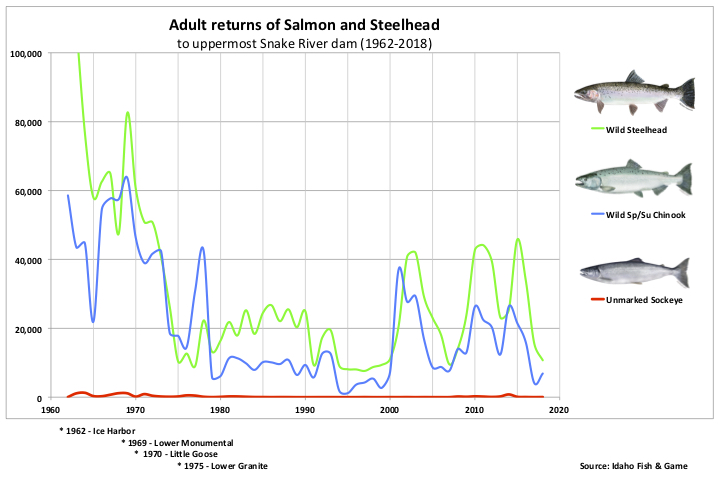forum
library
tutorial
contact

Can Decade-old Owyhee Initiative Model Bring Peace
Among Adversaries to Save Idaho Salmon?
by Rocky Barker
Idaho Statesman, October 28, 2019
|
the film forum library tutorial contact |

|
Can Decade-old Owyhee Initiative Model Bring Peace
by Rocky Barker
|
 MARSING -- Owyhee County rancher Chris Black says his life and his business has improved since the day Wilderness Society Director Craig Gehrke walked into his kitchen seeking his support.
MARSING -- Owyhee County rancher Chris Black says his life and his business has improved since the day Wilderness Society Director Craig Gehrke walked into his kitchen seeking his support.
Together, along with Idaho Republican Sen. Mike Crapo, they passed legislation protecting wilderness and ranching a decade ago, creating a model that transformed public lands management. The same kind of collaborative process is going to be necessary to save Idaho's wild salmon and protect wheat shippers, farmers and Snake River communities, Crapo said.
Especially if breaching dams is part of that discussion.
"You can get solutions that are better for all sides involved," Crapo said in a telephone interview.
Black's meeting with Gehrke was very different than how conservationists and ranchers had been interacting in those days. They clashed in crowded courtrooms and angry public hearings.
This time it was different because the Owyhee County Commissioners and Crapo had organized in 2001 what became known as the Owyhee Initiative to seek common ground over protecting the land and ranchers' livelihoods.
The sculpted canyons and mahogany-covered highlands of Owyhee County had become one of the West's most contested places — with fights over whether to remove cattle or stop Air Force bombing training. The Clinton administration had considered proclaiming the Owyhee and Bruneau river canyons and sagebrush habitat as a national monument in 2000.
"We missed a monument designation by the stroke of a pen," said Murphy rancher Brenda Richards, a decision that would have taken control out of local hands.
The Owyhee Initiative brought together ranchers, local officials, conservation groups (including The Wilderness Society, the Nature Conservancy and the Idaho Conservation League), outfitters, the Air Force, the Shoshone-Paiute Tribe and motorized recreationists on equal grounds to protect their common values. Gehrke had to meet personally with every rancher who would be affected by the wilderness protection he was proposing.
"Because they were willing to come into my house, that was a big deal," Black said.
It took the group eight years to develop the specifics of the legislation and the trust to carry it forward to Washington. In 2009, President Barack Obama signed a bill protecting 517,000 acres as wilderness, closed land to development, created 316 miles of Wild and Scenic Rivers and a set a series of actions aimed to help preserve ranching. Another 200,000 acres of wilderness study area was turned back into general public land open to motorized travel, mining and other activities.
But the power of the collaborative went beyond the passage of the law and boundaries of Owyhee County. A decade later, similar collaborative partnerships have spread throughout Idaho and the West.
Environmentalists and loggers joined Idaho officials and then Gov. Jim Risch in developing an Idaho rule to protect 9 million acres of roadless national forests in the state and replace a plan put in place by the Clinton administration. With sportsmen, snowmobilers and leaders in the timber industry, conservation groups have negotiated forest restoration programs across the state.
With their dual power in Washington, they have attracted millions of dollars for restoration programs and gotten behind the Good Neighbor Authority and Shared Stewardship restoration programs Gov. Brad Little touts for increasing management on national forests.
"There was a lesson we learned," Gehrke said. "We needed to meet rural people on their own turf."
The Owyhee Initiative group still meets regularly and works together to support each other's interests. Congress changed some wilderness boundaries in 2018 in a bill carried by Crapo and supported by The Wilderness Society and other conservation groups.
That helped Black, a fifth-generation rancher, to continue his cattle feeding as he had in the past. He said the agreement has improved his life.
"Personally I've gained in feed, gained in the ability to operate and gained for my family to continue to go on into the future," Black said.
"If you look on these ranges out here, they're in better shape than they've ever been," Black said. "That means there is an ability to run more cattle."
This month Gehrke brought to the Initiative board an Air Force proposal to expand low-level training flights over the Owyhees, which he worries will undo a compromise reached in the 1990s. The Air Force was a part of the initiative but hasn't participated for years.
He's hoping he can get his concerns over noise and other impacts addressed through the Initiative.
Elsewhere, The Wilderness Society has changed its approach to working with communities based on the Owyhee model. It recently put an organizer in Salmon to work with local residents on national forest and other land management planning.
Collaboration takes patience, Crapo said. You can't leave anyone out.
"You have to get all of the appropriate stakeholders to the table," he said.
On the salmon and dam issue, Crapo said in 2009 all solutions need to be on the table -- including breaching dams. His efforts to start talks went nowhere.
But Republican Rep. Mike Simpson suggested at an Andrus Center for Public Policy conference in April on salmon and energy that it was time for those who depend on Snake River dams to consider "what if" the dams were removed and what they would need to stay whole. Getting everyone to the table in the Owyhees told time, Crapo said.
"We won't resolve (salmon and dams) until we do it in a collaborative fashion," Crapo said. "That doesn't mean it will be easy."
learn more on topics covered in the film
see the video
read the script
learn the songs
discussion forum
